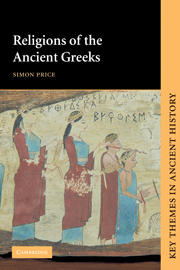Book contents
- Frontmatter
- Contents
- List of figures
- Preface
- List of abbreviations
- 1 Introduction
- 2 Gods, myths and festivals
- 3 Religious places
- 4 Authority, control and crisis
- 5 Girls and boys, women and men
- 6 Elective cults
- 7 Greek thinkers
- 8 Reactions to Greek religions
- Appendix of Greek inscriptions in translation
- Bibliographical essay
- Bibliography
- Index
Appendix of Greek inscriptions in translation
Published online by Cambridge University Press: 05 June 2016
- Frontmatter
- Contents
- List of figures
- Preface
- List of abbreviations
- 1 Introduction
- 2 Gods, myths and festivals
- 3 Religious places
- 4 Authority, control and crisis
- 5 Girls and boys, women and men
- 6 Elective cults
- 7 Greek thinkers
- 8 Reactions to Greek religions
- Appendix of Greek inscriptions in translation
- Bibliographical essay
- Bibliography
- Index
Summary
I have used square brackets for words that are no longer preserved in the surviving text; round brackets for parentheses in the original; and curly brackets for places where I have translated or explained technical terms. Readers might like to be reminded here of the monetary units that occur in these texts:
6 obols = 1 drachma
2 drachmas = 1 stater
6000 drachmas = 1 talent.
In the fifth century BG I drachma was the daily wage for a skilled labourer.
Sacrificial Calendar from the Attic Deme of Thorikos (430s BC?)
While the state of Athens had its sacrificial calendar, the constituent demes of Attica each had their own, interlocking calendars (above, pp. 28–30). There follows the calendar of Thorikos, which lies at the south–east of Attica. The sacrifices are organised under the twelve Attic months (see above, Fig. 2.g). The sacrifices here have both central and local interest. The layout of the translation indicates the (hypothetical) grouping of sacrifices.
- Type
- Chapter
- Information
- Religions of the Ancient Greeks , pp. 172 - 182Publisher: Cambridge University PressPrint publication year: 1999

